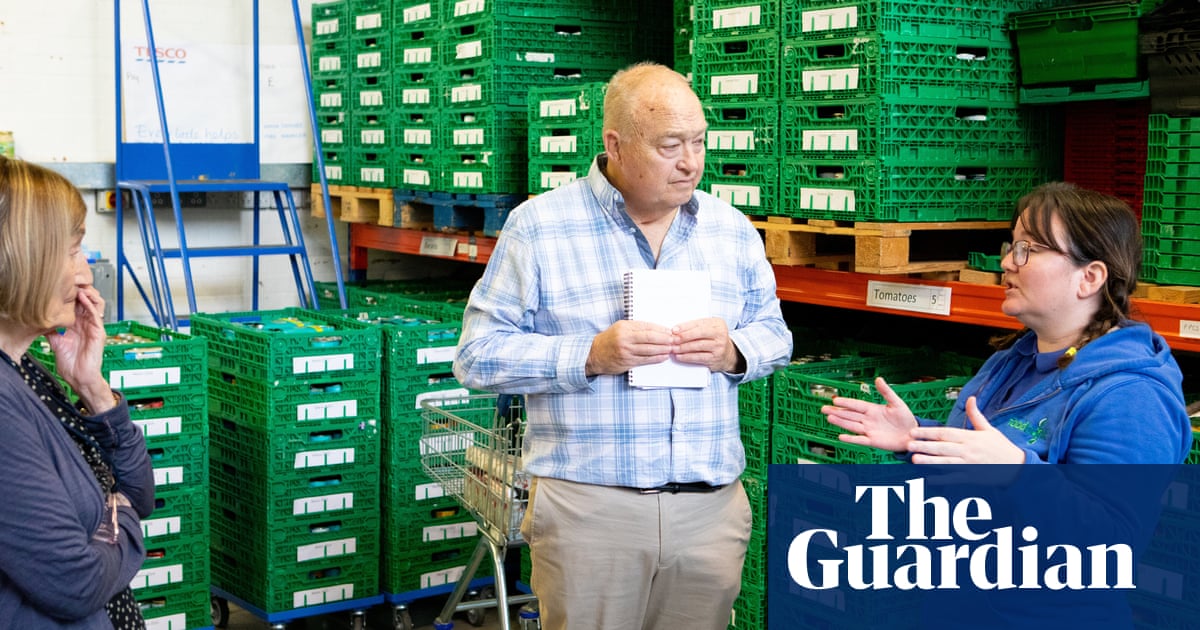
A long serving volunteer at one of England’s first food banks has said they had no idea the service would change society and become “part of the culture”.
Graham Herbert, 54, started volunteering at Salisbury food bank more than 20 years ago when it was a pioneering service and – unbeknown to him and his fellow volunteers – set to change the welfare landscape.
“There was nothing like it really,” Herbert says from the warehouse in Salisbury. “There was nothing on the scale. It’s now become part of the culture, it changed the society.”
The Salisbury food bank’s first incarnation was a shed in the garden of the founders of the Trussell Trust charity, which now supports more than 1,300 foodbank centres across the country. Trussell Trust food banks distributed close to 3m emergency food parcels to people facing hardship in the 2022-23 financial year, an increase of 37% on the year before.
Carol and Paddy Henderson founded the Trussell Trust in 1997 based on a legacy left by Carol’s mother, Betty Trussell. The trust’s first projects focused on improving conditions for the 60 plus children sleeping at Central Railway Station in Bulgaria.
In 2000, after his appearance in a local newspaper, Paddy Henderson received a call from a mother in Salisbury, who was struggling to afford food and faced sending her children to bed hungry.
After looking at data on poverty and deprivation in the UK and finding that significant numbers of people faced going hungry as a result of a sudden crisis, he started Salisbury food bank in his garden shed and garage, providing three days’ emergency food to local people in times of need.
From there, they developed a model of referrals and donations that spread rapidly, initially through church networks.
Herbert, who was in his early thirties when he started volunteering, joined the Salisbury food bank when it had moved from the shed at the Hendersons’ to another “shack” in one of the city’s churchyards.
“I recall everything was stored in cardboard crates with the food in, so the lower boxes were crushed,” he says.
Maria Stevenson now manages the Salisbury food bank centre, after starting as a volunteer five years ago in nearby Amesbury.
She explains that the Hendersons realised they needed to establish some form of referral system and initially turned to local doctors to help identify people in need.
Now, she says, she has more than 300 sources of referral across the area, including GPs, schools and churches. The service has expanded beyond providing food, with users often referred for help elsewhere such as mental health provision.
While it is often seen as a service for those with children, Stevenson says there have been a growing number of single men using the food bank. “That always surprises me,” she says. “The [number of] men has increased since Covid, which I think is due to relationship breakdown, or breakdown in family units.”
The number of people supported by the food bank has risen from 350 in 2018 to 900 in January 2023, although the number does seem to be declining now, she says.
Stevenson says the current operation is on a scale the original volunteers could never have expected. Food donations are stored and sorted at a 4,800 sq ft warehouse, with more than 100 volunteers helping across eight sites to distribute food to those who need it. The days of squashed cardboard boxes are gone, replaced by a more professional storage system.
She says a line from a children’s picture book called It’s a No Money Day by Kate Milner sums up her motivation to help. “There’s no more cereal, so I have the last piece of toast, luckily mum isn’t hungry,” she reads, adding: “That mum is giving up everything and going without and that’s a real-life struggle in 2023.”












